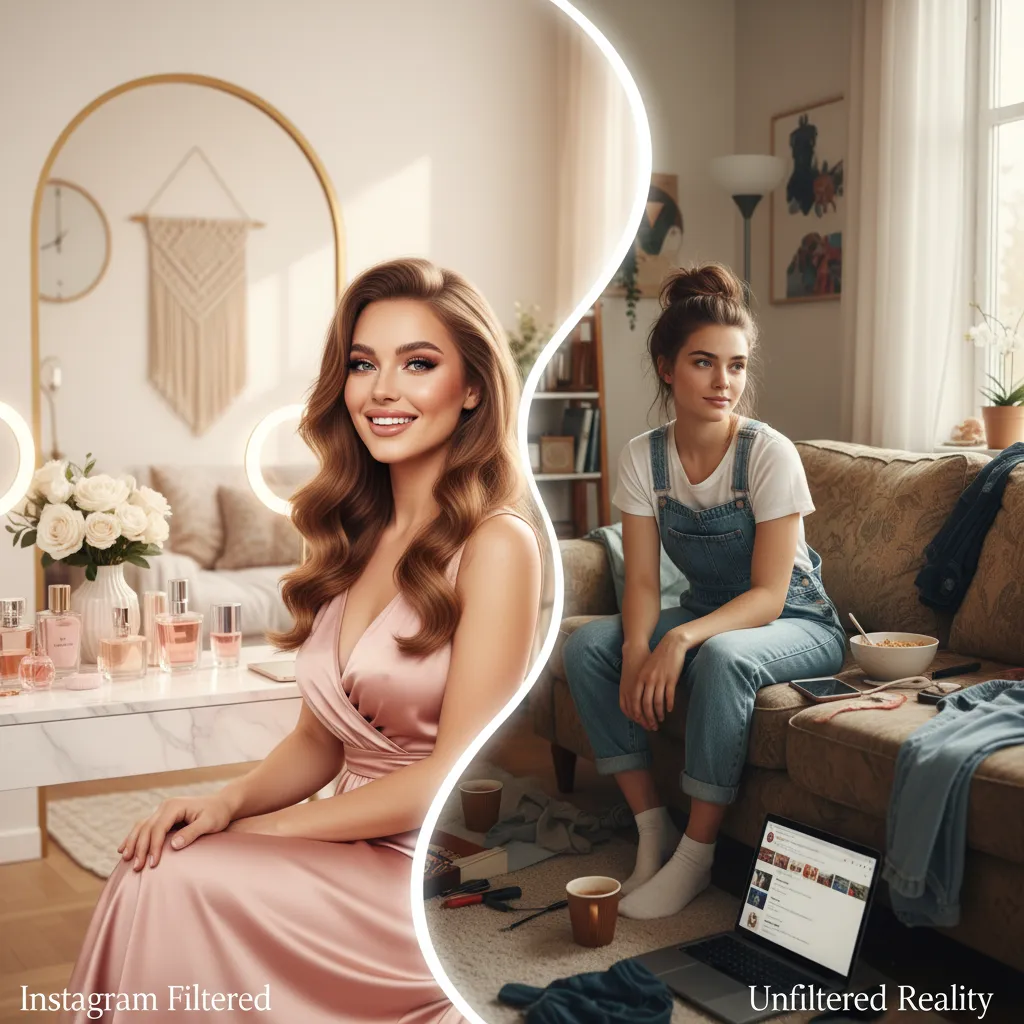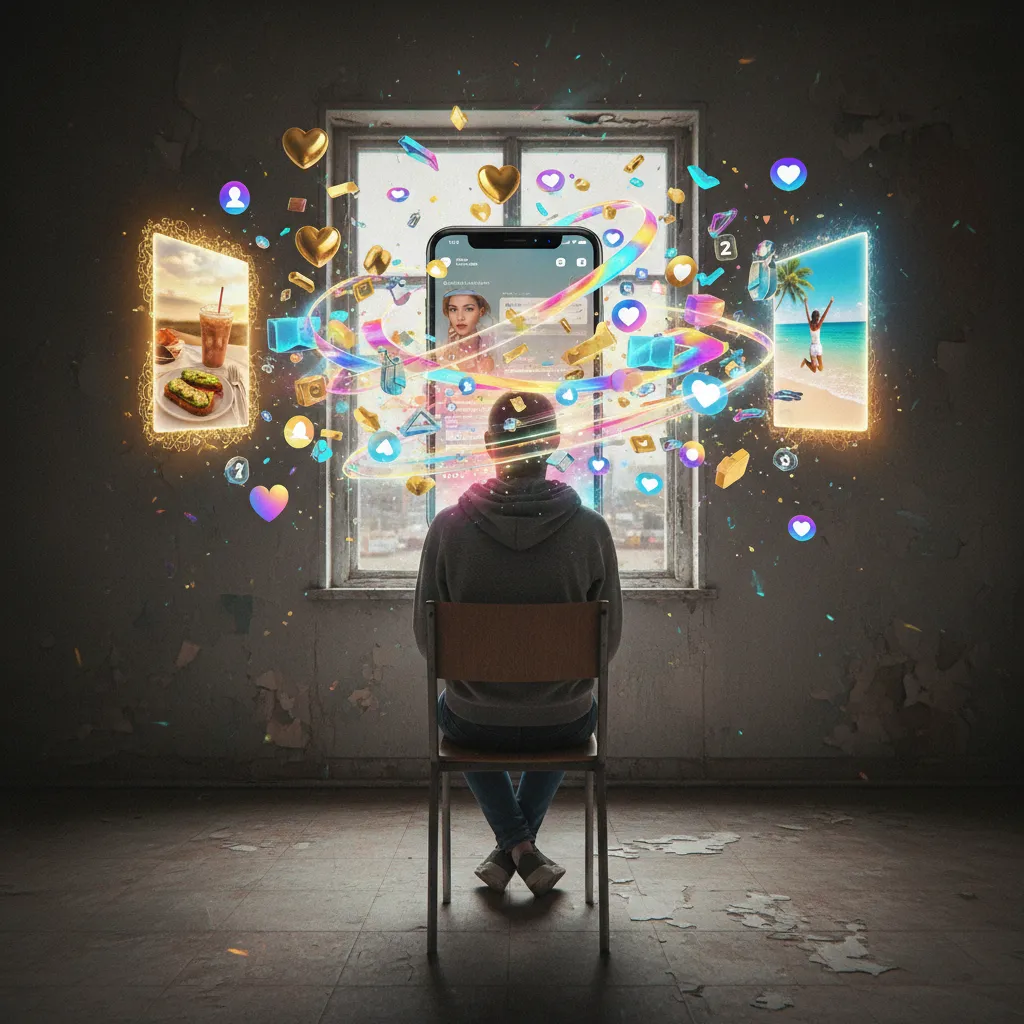I'll admit it. There are days when I stare at my phone and think, 'Why doesn't my world look like that?' Maybe it's the flawless minimalist rooms plastered across Instagram, or the wardrobes dripping with labels far out of my tax bracket. The feeling of being left behind? Oh, it's real—especially when the algorithm keeps feeding you seemingly perfect lives on repeat. But is this polished reality even... reality? Let's get uncomfortably honest about the mental gymnastics of keeping up with someone else's highlight reel.
Behind the Glam: Peeking Past the Instagram Filter
Why Curated Feeds Skew Our Sense of 'Normal'
Social media use has a powerful impact on the way you see yourself and others. Every time you scroll through Instagram, you’re met with perfectly styled rooms, flawless outfits, and seemingly effortless lives. But what you don’t see is the reality just outside the frame. The pressure to keep up with these curated feeds can warp your sense of what’s normal, making everyday mess and imperfection feel like something to hide.
It’s easy to forget that most people don’t live in magazine-ready homes or have endless wardrobes. Yet, the constant exposure to these “aesthetic” posts can lead to self-esteem effects, making you feel like you’re falling short. Research shows that excessive social media use can lower self-esteem, especially when you’re always comparing your real life to someone else’s highlight reel.
What You Don’t See: Messy Lives Behind Cropped Frames
“What you don't see is right beside me or right in front of me...” This confession is at the heart of social media’s aesthetic pressure. When you look at a polished video or photo, you’re only seeing a tiny, carefully chosen slice of someone’s life. The rest—the laundry piles, the clutter, the everyday chaos—is cropped out.
For many creators, making content means rearranging their entire space just to get that “okay” backdrop. You might not realize that right outside the camera’s view, there are housecoats hanging on doors, bridesmaid dresses tucked away, and piles of stuff pushed aside. The reality is, most people don’t live the lives they’re portraying online. The backdrop may look perfect, but it’s often just a small, staged area in an otherwise normal, messy home.
Confession Time: The Lengths We Go to for an 'Okay' Backdrop
If you’ve ever felt like your own space isn’t “Instagrammable,” you’re not alone. Many content creators admit to going to great lengths just to make their backgrounds look presentable. Here’s a behind-the-scenes look at what often happens before hitting record:
- Moving laundry baskets and clutter out of the frame
- Taking down housecoats or special-occasion dresses from doors
- Rearranging furniture or adding temporary decorations
- Hiding everyday mess just out of sight
This effort is driven by the fear of being judged for not having a “pretty” house or the latest trends. As one creator shared, “Every time I film, I take it down because it looks like garbage or all the crap that is usually laying here. I always have to move it in order to make my background look a little bit more appealing.”
The Reality Behind the Aesthetic Pressure
Social media impact goes beyond just what you see. It highlights wealth, consumerism, and lifestyles that are often inaccessible for most people. The truth is, being “non-aesthetic” isn’t a flaw—it’s normal. But when every feed is filled with curated perfection, it’s easy to forget that most people are just like you: living in spaces that are lived-in, not staged.
What you don't see is right beside me or right in front of me... the reality is is that most people don't live the lives they're portraying.
Seeing more creators share their real, unfiltered lives is refreshing, but the pressure to appear perfect remains strong. Remember, the next time you scroll, that the “glam” is often just a filter—real life is happening just out of frame.

Numbers Don’t Lie: The Canadian Cost of Playing Pretend
When you scroll through social media, it’s easy to feel like everyone is living a life filled with endless shopping sprees, perfect homes, and trendy outfits. But when you look at the real numbers behind the average Canadian lifestyle, the truth is much less glamorous. Understanding Canada salary statistics and the real cost of living can help you see why keeping up with online trends is simply out of reach for most people.
What Most Canadians Really Earn
The average full-time salary in Canada is about $63,000 per year. But that number doesn’t tell the whole story. Many Canadians—especially those working minimum wage jobs in retail or service—bring home much less. If you’re earning minimum wage, your yearly income is likely between $30,000 and $32,000. That means every two weeks, you might see about $900 on your paycheque. For many, this is the reality, not the exception.
The Cost of Just Getting By
Let’s break down some basic monthly expenses:
- Average rent: $2,196
- Groceries for a family of four: $1,296
Already, if you add these together, you’re looking at nearly $3,500 a month just for a place to live and food to eat. That’s before you even think about gas, car insurance, car payments, phone bills, or subscriptions. As one Canadian put it:
Already if we get all of this together we are in the negatives and this doesn't even include gas money, car insurance...
For many, the math just doesn’t add up. Even with the average salary, necessities often outpace income. If you’re on minimum wage, you’re likely already in the red before you even consider the “extras.”
The Price of Social Comparison Anxiety
Social media is full of people showing off matching kitchen containers, the latest viral clothing brands, and picture-perfect homes. But for most Canadians, these things are out of reach. The pressure to keep up with these online standards can lead to social comparison anxiety, making you feel like you’re falling behind when, in reality, you’re simply living within your means.
Trying to match these “aesthetic” lifestyles isn’t just unrealistic—it can be harmful. Research shows that financial pressure from trying to keep up with social media-fueled consumerism can directly worsen depression and anxiety. When you’re already living paycheck to paycheck, seeing endless displays of wealth online can make you feel inadequate or stressed, fueling the cycle of social media addiction effects.
Economic Reality vs. Online Personas
Most Canadians are already stretched thin by basic living expenses. The online version of “success”—with its designer brands, luxury apartments, and constant upgrades—simply doesn’t reflect the economic reality for the majority. When you see influencers living their “best lives,” remember that for most, these images are just that: images, not reality.
In Canada, the numbers don’t lie. The cost of playing pretend online is more than most can afford, and the pressure to do so can take a real toll on your mental health and financial stability.
Comparison is a Thief: Social Media's Mental Health Toll
If you’ve ever scrolled through your feed and felt like you’re falling behind, you’re not alone. In fact, feeling “behind” is now the rule—not the exception—especially for young adults and teens. Social media platforms are overflowing with more than 25 different aesthetic subcategories, each one promising a new version of the “ideal” life. From “that girl” to “vanilla girl” to “soft girl,” these trends constantly shift the goalposts for what’s considered normal or desirable. As a result, many people find themselves caught in a cycle of online social comparison, chasing ever-changing standards that are often unattainable.
This endless comparison doesn’t just sap your joy—it has real, measurable mental health effects. Research shows that excessive social media use and upward social comparisons are directly linked to increased anxiety, depression, and poor self-worth. According to recent studies, nearly 40% of adults report feelings of loneliness or isolation due to social media. For adolescents, the impact is even more severe. Social media comparison anxiety significantly impacts mental health, leading to increased anxiety, depression, and poor body image, especially in adolescents and young adults.
How Online Social Comparison Fuels Anxiety and Depression
The explosion of aesthetic subcultures online means you’re constantly exposed to new lifestyles, products, and identities. Each scroll brings a fresh wave of content urging you to buy more, do more, and be more—or sometimes, to be less, depending on the trend. The pressure to fit into these categories can make your own life feel inadequate by comparison. You might admire the curated routines, spotless apartments, or effortless style of influencers, but the reality is that most people can’t afford to keep up. As one creator put it, “Social media is destroying our sense of normal.”
- Constant comparison: Seeing others’ highlight reels can make your daily life seem dull or lacking.
- Shifting standards: With over 25 aesthetic subcategories, the “ideal” is always changing.
- Buying pressure: Trends often push you to purchase new products or adopt new habits to fit in.
- Identity confusion: Trying to conform to multiple aesthetics can leave you feeling lost or inadequate.
Adolescents’ Mental Health at Risk
Adolescents and young adults are especially vulnerable to these mental health effects. Their sense of identity is still forming, making them more likely to internalize unrealistic standards. Studies consistently show that online social comparison is linked to higher rates of anxiety, depression, and loneliness in this age group. The constant exposure to curated perfection can erode self-esteem and create a sense of never being “enough.”
Social media comparison anxiety significantly impacts mental health, leading to increased anxiety, depression, and poor body image, especially in adolescents and young adults.
It’s important to remember that what you see online is rarely the full story. The pressure to fit into a certain aesthetic or lifestyle can be overwhelming, but your worth isn’t defined by how closely you match a trending category. Real life is messy, imperfect, and unique to you—and that’s okay.
 Gratitude over ‘More’" />
Gratitude over ‘More’" />Reclaiming Reality: Choosing Gratitude over ‘More’
It’s easy to lose yourself in the endless scroll, where every photo seems perfectly lit, every room immaculately styled, and every life just a little shinier than your own. But what if you paused the scroll for a moment and looked around at your own life—the messy, imperfect, everyday moments? What if, instead of chasing “more,” you chose gratitude for what’s already yours?
Social media use can have a real impact on self-esteem and mental health. The pressure to keep up with curated feeds often leads to comparison-driven anxiety. Many content creators admit they feel compelled to stage perfection, fearing judgment for sharing their true, non-aesthetic realities. Yet, as one creator put it,
“There needs to be more... content online that shows what normal people live like. Being non-aesthetic is not unesthetic. It’s normal.”This shift toward authenticity online is more than a trend—it’s a movement that can help us all reclaim reality.
Spotting the real in your routine means noticing the hand-me-downs in your closet, the DIY touches in your living space, and the small victories that don’t make it to Instagram. Maybe your bedroom isn’t Pinterest-perfect, or your makeup lives in a basket you carry to the bathroom. Maybe you haven’t bought new clothes in years, and your travel stories are still dreams for the future. These details aren’t failures—they’re part of a life honestly lived. When you see others sharing their unfiltered realities, it’s a reminder that you’re not alone in the ordinary. In fact, research shows that sharing authentic experiences online can reduce anxiety and foster a healthier relationship with social media.
Practicing gratitude—literally counting your blessings—has been linked to improved mental health outcomes. It’s about shifting focus from what’s missing to what’s present: a roof over your head, a job that pays the bills, relationships that matter. Even when finances are tight and life feels less than glamorous, gratitude can anchor you to what’s real and good. As the creator shared, “I have so much. I am so blessed.” This mindset doesn’t ignore challenges, but it helps you see value beyond material standards.
Imagine, for a moment, an “unfiltered Instagram challenge.” Would you dare to post your real, unedited life—the laundry piles, the thrifted jeans, the meals that didn’t turn out picture-perfect? What if more people did? The more we normalize ordinary, unfiltered content, the more we dismantle the myth that everyone else’s life is flawless. Authenticity online isn’t just refreshing; it’s necessary for our collective mental health.
In the end, reclaiming reality means accepting where you are, embracing the messy and the mundane, and choosing gratitude over the endless pursuit of “more.” When you stop comparing and start appreciating, you find freedom—and maybe even joy—in the life you’re already living. Let’s normalize the normal, celebrate the real, and remember that being non-aesthetic is, in itself, a beautiful kind of aesthetic.
TL;DR: Scrolling past curated perfection can leave you feeling less-than, but you’re not alone—and you’re not behind. Most people can’t (and don’t) live up to those 'aesthetic' standards. Your messy, budget-conscious, real-life existence is more normal—and worthy—than the internet lets on.



